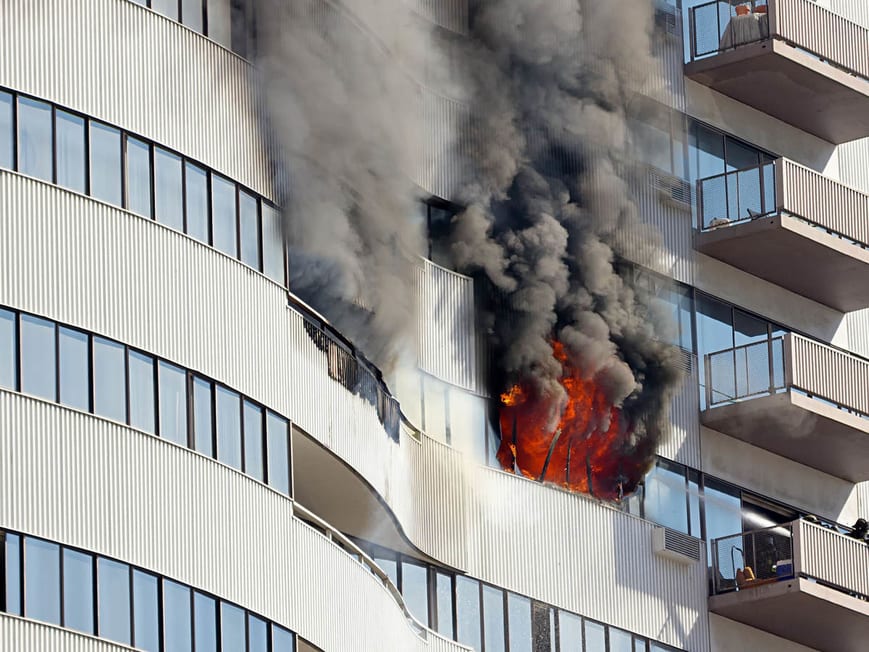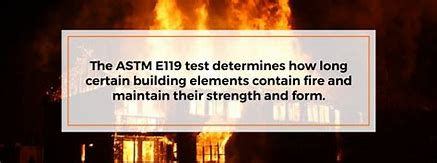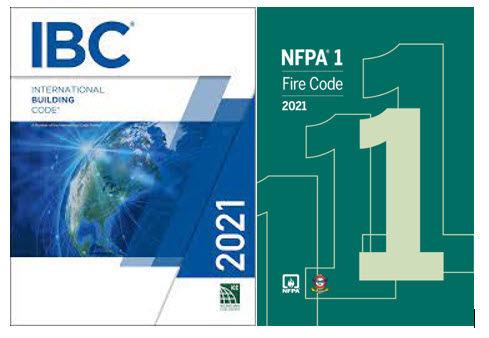
Structural thermal breaks are located within the thermal envelope of a building. Their purpose is to provide a break in structural connections that otherwise conduct heat through the exterior insulation. Thermal breaks are installed within exterior walls, roofs and framing connections that can require a fire resistance rating.
Do materials used as thermal breaks have an impact on this rating? If they are combustible, the answer may be yes. What should you know about the fire properties of thermal break materials? (photo credit: UL laboratories)
Discussion points:
- Fire Resistance Rating and Building Code
- Combustibility
- Fire Properties of thermal break materials
- Building code and the use of combustible materials
Fire Resistance
Building construction types are classified as either combustible or noncombustible. Type I and type II buildings require all materials to be noncombustible. Types III and IV require noncombustible exterior walls but allow for the use of combustible materials in other areas. Type V allows for combustible materials to be used anywhere. While the building code allows for some exceptions for each construction type, the building elements used in types I through IV must have a fire-resistance rating that meets the requirements of the International Building Code.
The fire resistance rating is based on the period of time a building element can withstand or continue performing its structural function due to a fire. The rating is achieved by conducting an assembly test per ASTM 119 “Standard Test Methods for Fire Tests of Building Construction and Materials.” These building elements include exterior walls, roof structures, floor structures, primary structural frames, etc.
The fire resistance rating of building elements and the flame spread characteristics of the building materials within these elements are two of the main fire-related concerns for designers and building code authorities. Determining how materials react to fire exposure is important in establishing how local building codes permit their use.
How does this relate to materials used as thermal breaks?
Many thermal break solutions or materials are combustible or contain combustible components. There are important factors to consider when a combustible material is used in building construction: the amount of the combustible material, its arrangement within the building element (vertical or horizontal), the materials surrounding it and its fire related properties. These are all used in making an assessment as to whether the required fire resistance rating of the building element is likely to be affected.
Combustibility
In section 220 of its code, the NFPA defines building construction materials as either “noncombustible”, “combustible” or “limited combustible.”
A noncombustible material will not ignite, burn or support combustion when subjected directly to fire or heat. The material complies with and passes the ASTM E 136 test for combustibility.
A limited combustible material does not meet the requirements of ASTM E 136; however, it exhibits a potential heat value not exceeding 3500 Btu/lb. per NFPA 259 and has a flame spread index of 25 or less (without evidence of progressive combustion) per ASTM E84.
Combustible materials are capable of igniting, burning and adding fuel load that would enable fire to grow and spread.
It is worth noting that combustible materials that have a low flame spread index value do prevent the spread of fire by not melting or dripping when directly exposed to flame or extreme heat. They are also typically self-extinguishing; however, by definition – they can ignite/combust.
Fire Properties of Thermal Break Materials
Therefore, in addition to flame spread, the potential heat value and heat release rate of a combustible material should be given careful consideration with regard to fire risk as it relates to a building element fire resistance rating. The flammability and subsequent heat release properties of a material could increase the rate of a fire hazard as well as a fire’s intensity and duration.
Potential heat value: the amount of heat released during combustion
Heat release rate: the rate at which heat is generated once burning. A higher rate means the fire burns with a higher intensity.
What if a thermal break material is said to be fire retardant or fire resistant? A material may be resistant to catching fire; however, if it has the ability to ignite, it is still considered combustible.
The terms “non-combustible” and “fire retardant” are often confused, but there is a very important difference. If a material is non-combustible, it will not burn. Fire retardant materials will contribute to a fire once they combust.
Building Code and the use of Combustible Materials
For all building types other than type V, where combustible construction is allowed, local code officials could ask for a thermal analysis in the form of an engineering assessment (engineering judgement) to address fire resistance. The analysis uses the fire related properties of all the building materials in an element assembly. In some cases, the official may require an ASTM 119 fire test (or smaller scale test) be performed on the building element assembly to verify its fire resistance value.
These decisions consider:
The amount of the combustible material
The material orientation within the building element (vertical or horizontal)
The other building materials surrounding the combustible material
The combustible material’s fire related properties.
As an example, in chapter 14 of the International Building Code, exceptions are made for combustible water-resistant barriers (WRB) based on meeting minimum test results that address potential fuel load and other fire related properties. Additionally, the WRB must be covered by an exterior wall constructed with non-combustible materials. Thermal break materials are typically installed on top of or interface with the WRB in a wall assembly. Therefore, the same guidance could be used when addressing thermal break materials for assemblies not requiring NFPA 285* per IBC chapter 26.
*Exterior wall assemblies using combustible materials, such as thermally broken cladding attachments, require an NFPA 285 wall assembly fire test as a code requirement.
ASTM and CAN/ULC fire standards in North America help ensure products, materials and assemblies are adequately tested to demonstrate performance consistent with fire safety. These standards also help to ascertain the degree to which a fire is likely to start or develop. They also help determine product and assembly behavior when exposed to heat and flames.
Using non-combustible thermal break materials where and when possible, eliminates the need for additional assembly testing and/or engineering judgements based on material fire properties.

References
Arsenault, Peter. “Balancing Fire and Energy Code Requirements in External Walls”
Fitzgerald-Pitts, Jeanette. “Code-Compliance Conflicts in the External Wall Assembly”
Rockwool Group, “Built in Protection”



